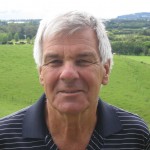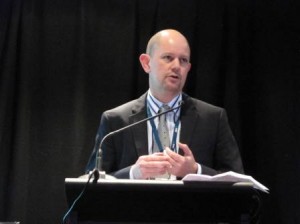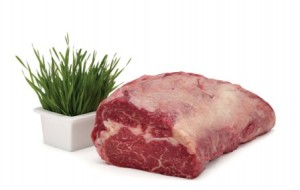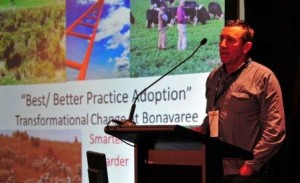 One farmer who has made transformational change to his farm business is Marlborough farmer Doug Avery.
One farmer who has made transformational change to his farm business is Marlborough farmer Doug Avery.
In an inspirational and entertaining presentation at the Red Meat Sector Conference, he talked of working “smarter and harder” and the need to “lift yourself up above and see what’s going on around you.”
The tipping point that made him see that he needed to change was sustained drought in the region, over a period of eight years, which meant that Bonavaree Farm and the Avery family were facing a very uncertain future. In 1998, Doug Avery attended a seminar where Lincoln University pasture Professor Derrick Moot proposed using lucerne as a primary grazing pasture plant. Using that idea started change.
In 2004, with the area still gripped with drought, the NZ Land Care Trust answered a call for help from Avery and a few other farmers. A six-pronged attack on failed systems was engaged with science and the help of funding from the Sustainable Farming Fund and others. This saw the transformational change of the operation from one of failure to one of success.
Having run the emotional gamut of the ‘Three Ugly Sisters’ – envy, anger and blame – Avery realised, when he started looking, that there were some things he could control and others he was concerned about – climate change, weather and the value of the dollar – that he had no control over at all.
Avery realised three things: that the farm business could run 44 percent less sheep but only produce five percent less product; also, that a one percent increase in soil carbon can increase water holding capacity by 144,000 litres per hectare; and, finally, “how much time do we spend telling our story?”
Change of mindset
A change of mindset was also needed, he decided. He would work in what he calls the influence circle, become proactive not reactive, move to solution and enquiry (away from blame and excuse), he would influence thinking and adapt his business systems to the changing climate.
Better practice influenced the systems in place at Bonavaree, says Avery. The year was broken down into three periods: the risk period from mid-December to mid-February where they farm as little as possible; the recovery period from mid-February to late winter, when crops are grown on summer-fallowed land and ewes and hoggets are mated on lucerne and the system charges back into life; and the revenue period, from late summer till mid-December.
“We grow our stock at fast rates to finishing weights before the summer dry,” he said, adding that ewes wean fat and the ewe weights are heavy.
Precious water was conserved by using summer fallow, which intercepted the weed cycle, storing water and creating a water reservoir. Organic matter was built into the soil by stopping tillage. Plants were used that could tap water from deeper layers and also create rapid animal growth and performance. Finally, animals were made for performance, using designer genetics.
Results
The results today speak for themselves. “Lots of wonderful lambs that grow like mushrooms”, and “hogget scanning gone from 40 percent to 165 percent”.
Today, Bonavaree has 1,500 hectares owned and 280 ha leased which will be wintering 13,000 stock units this year (5,000 sheep, 1,650 cattle), growing 90 ha of lucerne for seed and the family is retiring an increasing number of natural areas production. The property has six full-time staff and lots of busy contractors.
Better practice
Better practice for Avery is about using quality contractors, rather than trying to purchase expensive machinery and do it himself, using smart systems like Farmax, inspiring the young who learn by what they see, working with good value chains and smart brands, growing top crops and lambing onto top quality feed, he said.
Reminiscing to the start of his transformational journey, Avery said: “I always wondered why somebody didn’t do something about that, then I realised I am somebody.”
His message for farmers looking to create resilient businesses is to create relationships, manage the soil and water “more crop from every drop”, look at the plant selection for sites and purpose, manage feed supply and demand, work with the natural forces of the local climate, collaborate with science, agency and industry, engage in processes which create financial reward and to create a culture of excitement and fun in the work place.
Bonavaree is now looking to build on its successes through improved management structures, more measuring and collaboration through FarmIQ, better feed conversion in the rumen, improved plant mixes and genetics (plant and animal) and enhanced native plantings and over lay business, says Avery.
Doug Avery has received a number of award for his work at Bonavaree including the 2008 Green Ribbon from the Ministry for the Environment, 2010 Lincoln Foundation South Island Farmer of the Year, 2011 Marlborough District Council Farm Environment Award and the 2012 New Zealand Land Care Trust Ambassador title.
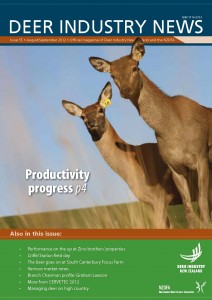 Moves are afoot to improve the productivity of New Zealand’s venison herd, which could result in an average carcase weight of 64 kg in ten years time, a better quality and improved supply of venison for exporters, along with improved earnings for producers.
Moves are afoot to improve the productivity of New Zealand’s venison herd, which could result in an average carcase weight of 64 kg in ten years time, a better quality and improved supply of venison for exporters, along with improved earnings for producers.


